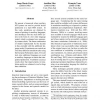406 search results - page 2 / 82 » Adaptive Language and Translation Models for Interactive Mac... |
IJCNN
2007
IEEE
13 years 11 months ago
2007
IEEE
— Serious efforts to develop computerized systems for natural language understanding and machine translation have taken place for more than half a century. Some successful system...
COLING
2010
13 years 8 days ago
2010
We present a framework where auxiliary MT systems are used to provide lexical predictions to a main SMT system. In this work, predictions are obtained by means of pivoting via aux...
LREC
2010
13 years 6 months ago
2010
Statistical machine translation (SMT) requires a large parallel corpus, which is available only for restricted language pairs and domains. To expand the language pairs and domains...
SNPD
2008
13 years 6 months ago
2008
In the social reality, objects communicate with each other by means of assuming roles to establish collaboration, and then can adaptively change their roles to obtain other intera...
EMNLP
2008
13 years 6 months ago
2008
Traditionally, statistical machine translation systems have relied on parallel bi-lingual data to train a translation model. While bi-lingual parallel data are expensive to genera...

